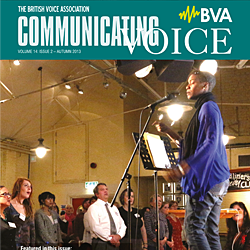About the Association
Van Lawrence Prize 2014
Efficiently and Cost Effectively Managing Teachers’ Voice Problems – (abstract)
Cecilia Pemberton
Voice injuries in teachers have long been researched and recognised as a significant problem in terms of cost to the education system, and the impact on teachers' well-being and on student learning. Research has examined the incidence of voice injuries in teachers in terms of gender, years of teaching, type of teaching, types of voice complaints, voice related absenteeism, treatment seeking behaviours and the impact of the working environment on the voice [1,2]. Programmes including vocal hygiene and targeted voice exercises have been trailed, as has the use of amplification as a means of preventing or reducing the impact of voice injuries for teachers. Recent studies have examined the measurement of voice use and vocal volume as a means of identifying the vocal load that puts teachers most at risk of a voice injury [3]. Overall, the research into voice injuries in teachers has determined that the workplace is significant contributing factor to voice injuries for teachers.
Many employers are aware of their responsibility and indeed the benefit of addressing their employees' personal and work-related issues through Employee Assistance Programmes (EAPs). EAPs have a long history and research demonstrating their cost effectiveness in managing workplace issues and reducing absenteeism that could otherwise be a considerable a financial burden to employers. This paper will discuss an EAP style programme established specifically to address the needs of teachers' voices.
A 2008 survey of teachers employed in a jurisdiction of 38 primary and secondary schools found that, commensurate with other international research, 26% of teachers reported they had experienced a voice problem in the previous 12 months. There was a high incidence of reported voice problems in the first five years of teaching (19%) and even higher incidence in the 16years + (41%). The teachers reported they took an average of 0.9 days sick leave per year because of a voice problem.
Using the information from this survey, and the available voice and EAP research data, an EAP style comprehensive Teachers Voice Care Project (TVCP) was developed. The TVCP was funded by the employer for a 12 month trial in 2008 and has run successfully and cost effectively each year since. The keys elements of the TVCP were:
- Voice injury prevention information: Each school has been provided with the Voice Care for Teachers DVD, Voice Care Tips poster to display in the staffroom, Voice Care Tips bookmarks for every teacher. A risk assessment checklist is incorporated in the Wellbeing Health & Safety manuals to be completed annually.
- Beginning teacher workshops: Voice care workshops are a compulsory component of the school induction programme, providing vocal hygiene information and voice care exercises.
- Employee Assistance Programme for Voice (EAPV): All teachers have access to four sessions for voice assessment and therapy, automatically funded by employer. This is designed to encourage early intervention. All sessions are provided at locations and times convenient to schools. The employer is not aware of the identity of the teachers attending for EAPV.
- Amplification: Schools are advised on effectiveness and usefulness of amplification for their context. Amplification systems are available for loan to any teacher experiencing voice problems.
Since 2008, 185 teachers have sought individual voice assessment and treatment. All were strongly advised to have an ENT examination; however access to EAPV was not contingent on this. Many of the teachers who attended EAPV had perceptually normal voices. They reported voice symptoms but did not feel they had a voice problem and chose not to have an ENT examination. They required only one or two sessions of therapy, for voice projection and resonance techniques, and required no further intervention. 84 teachers had an ENT consult, 35 teachers were diagnosed with phonotrauma, 26 with muscle tension dysphonia (MTD), 11 with other vocal fold changes and 12 had no apparent abnormality. Treatment consisted of individual sessions and when necessary reduced face to face teaching. All but one teacher have returned to their normal teaching duties and are managing their voices well, albeit with amplification. One teacher is still unable to manage her normal classroom duties.
Since the implementation of TVCP 1,500 teachers have had access to voice care prevention information. Two hundred beginning teachers have attended a voice care workshop providing information on vocal hygiene, release of constriction and resonance exercises. Twenty five teachers have been provided with, or purchased their own, personal amplifiers. Individual schools have installed amplification systems in some classrooms and purchased megaphones for outdoor duties. There has been a 30% reduction in the number of self-reported voice related sick days (self-reported sick leave: 2008 = 0.9 days; 2011 = 0.6 days). This has resulted in a net cost saving to the employer of approximately $500,000 in replacement teacher costs alone.
TVCP is an innovative, proactive, prevention and early intervention programme. It has successfully engaged the teacher population within this jurisdiction with voice care. It has provided a meaningful reduction in sick leave making it cost effective for the employer not solely in dollar terms but also employee relations. 12% of teachers have accessed voice assessment and treatment and another 12% have attended beginning teacher voice workshops. While TVCP provides a scalable model for efficiently and cost effectively dealing with voice injuries in teachers, it also raises further questions of how we accurately measure the incidence, severity and framework for treating teachers' voice problems.
References:
[1] Prevalence of voice problems in schoolteachers. Journal of Voice, 12, 467-479. Russell, A., Oates, J., Greenwood, K. (1998).
[2] Voice disorders in teachers and the general population: Effects on work performance, attendance, and future career choices. Journal of Speech, Language and Hearing Research, 47(3), 542—551. Roy,N. Merrill R., Thibeault, S., Gray, S., & Smith, E.(2004).
[3] Variations in intensity, fundamental frequency, and voicing for teachers in occupational versus nonoccupational settings. Journal of Speech, Language and Hearing Research 53(4) 862-875. Hunter E.J, &Titze I.R, (2010)

 Join us Now!
Join us Now! our newsletter
our newsletter free voice care leaflets & information – download here
free voice care leaflets & information – download here Help our work by donating while you shop
Help our work by donating while you shop